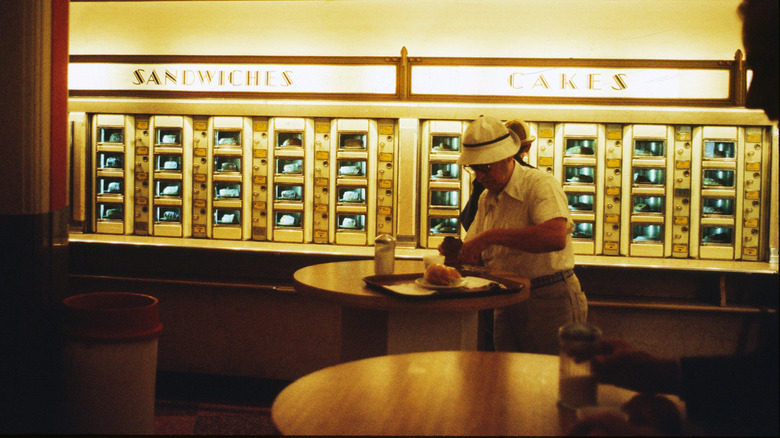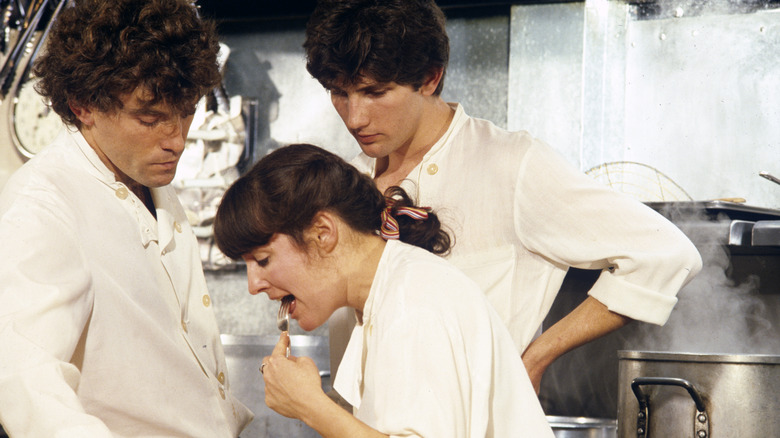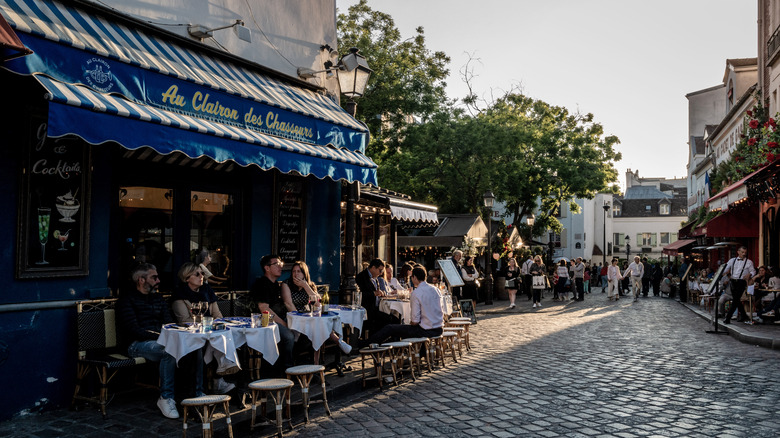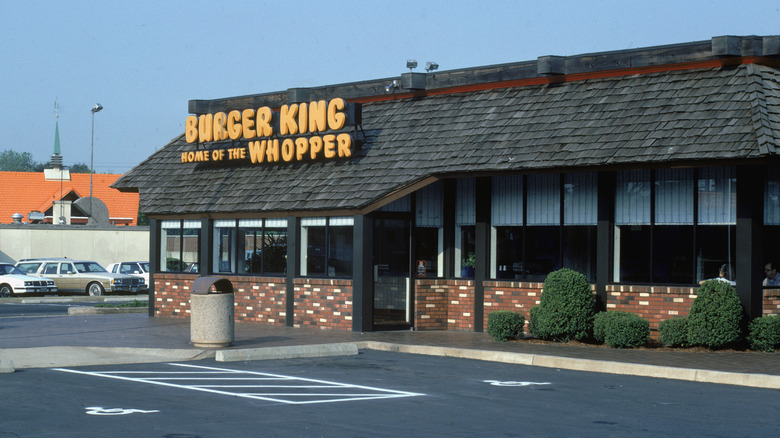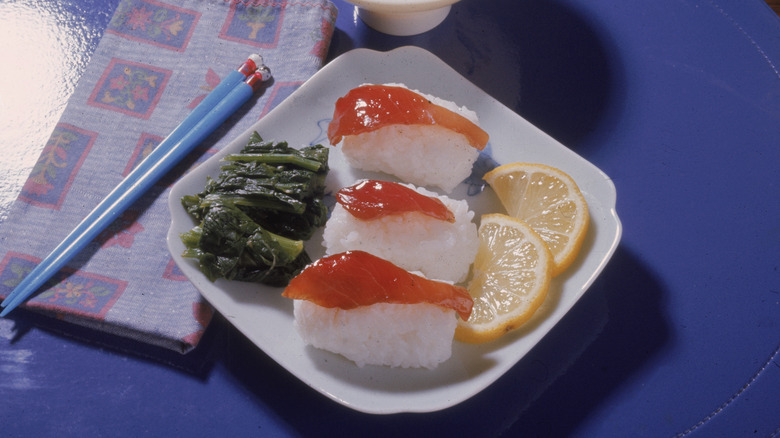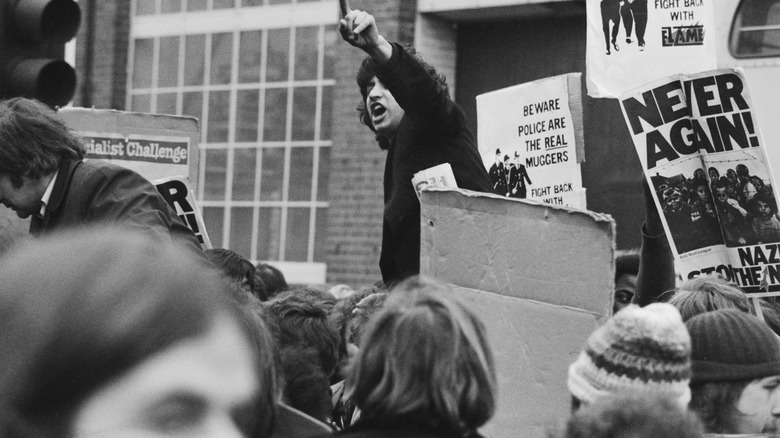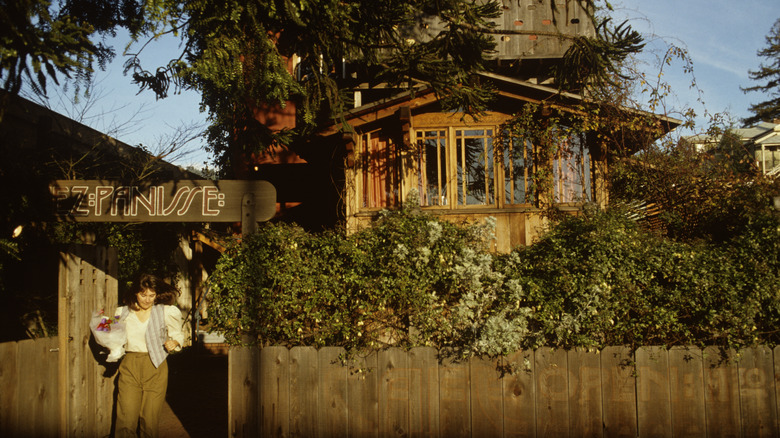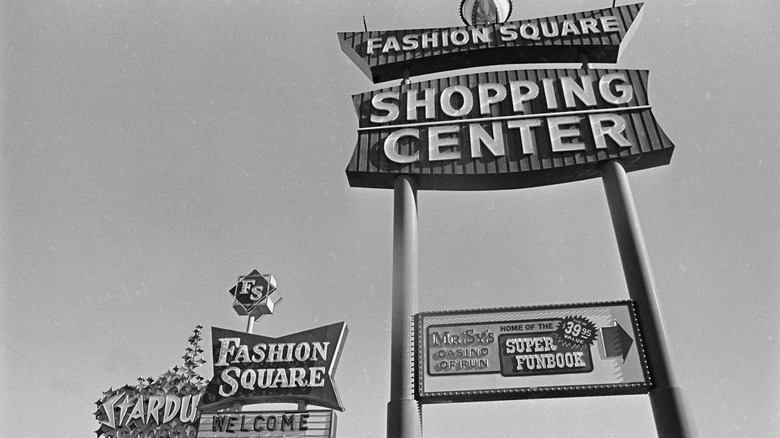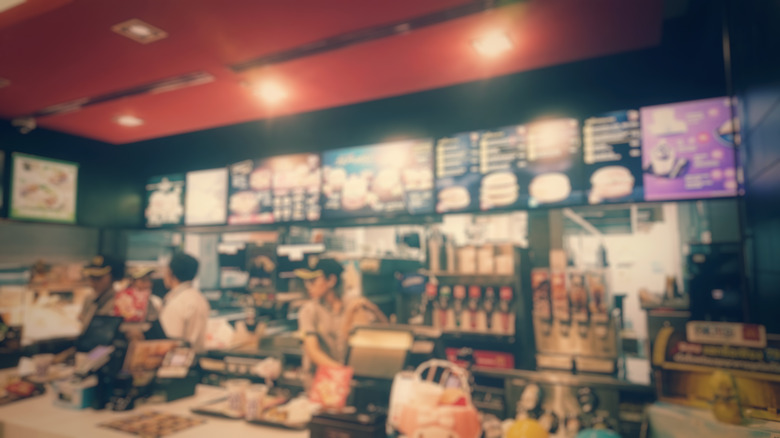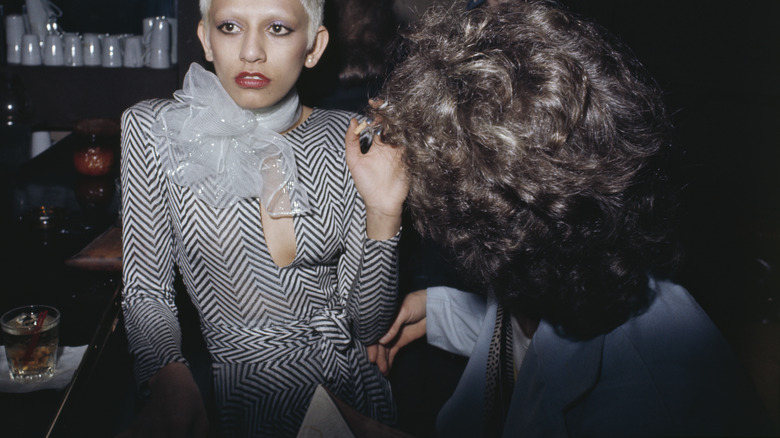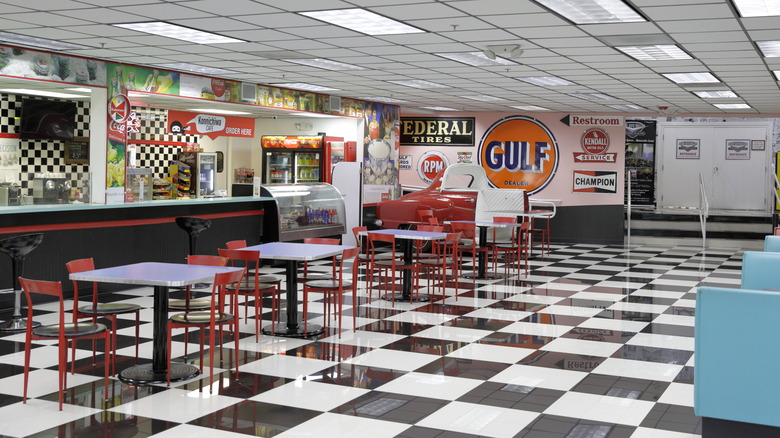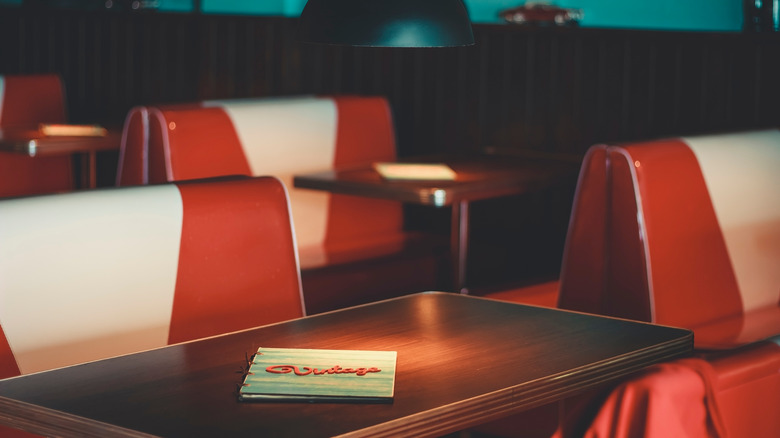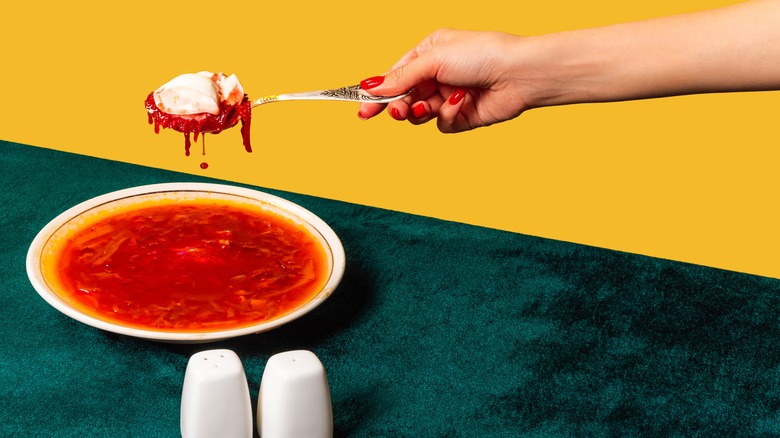What American Restaurants Looked Like 50 Years Ago
Yeah, baby! The 1970s was one of the most iconic and parodied decades of the 20th century. Described, maybe not affectionately, but iconically, as good times with bad taste, the '70s has long been the butt of many jokes and was even once described in The Seattle Times as the decade of choice for comedy. Sure, the jumpsuits, fondue, and viral ham and bananas hollandaise recipes have long been the subjects of both comedy and horror, but there might be something that we can't hear over the laughter.
The '70s offered a distinct step into the modern era, and many historical events and movements in style, art, and culture that define the world we live in happened at this time. This decade was all at once a time of great peace, conflict, financial instability, and globalization. The tumult was met with creativity, imagination, and a little bit of funk. It's certainly worth checking out and chewing on. All of these changes were represented in the kitchen and served on the table, especially at the restaurant. Now, a half-century removed from this important decade, you may be surprised at how much has changed and how much has stayed the same in the restaurants Americans frequent.
Contemporary restaurant cuisine began to change
While often gleefully dunked on online, the '70s offered a paradigm shift in the American diet. An increasing amount of different influences began to push the nation's dinner plate into what can be recognized as contemporary cuisine. This shift, of course, was reflected in restaurants. But what defined cuisine in the '70s and how did it really differ from that which was served before it?
An excerpt of the book "American Cuisine and How it Got This Way" in The Daily Beast argues that cooks in the '70s started rediscovering lost, or at least forgotten, cooking traditions. The '50s and '60s saw the rise of the modern consumer market and the homogenization of American restaurants. Some forward-thinking chefs in the '70s hit the brakes and rejected homogeneity in favor of regional cuisine and the beginning of the locavore movement. NY Foodstory also makes the observation that the liberalization of immigration laws led to an influx of new people to the United States in the second half of the 20th century. As more people immigrated from all around the world, they began to open small businesses, including many restaurants. This resulted in what the article described as a marked shift for people who loved food. The restaurant industry was changing in just about in every way and going in every direction.
The French influence on American cuisine
French food has long been romanticized and seen as a major foray into the indulgent, luxurious, and refined. When thinking about French cuisine, chef Julia Child is probably among the first to come to mind with both her books and TV show. She, in short, demystified French cooking according to one food historian.
This of course had a ripple effect on the professional dining room. While it wasn't the end for the high-end French restaurant, the 1970s saw a reinvention of French cuisine in the States (via Fine Dining Lovers). This is reflected in the bistro burst of the '70s, as observed by The Washingtonian, a time when easy-going and laid-back French eateries began entering the mid-level dining scene. This can also be seen in the proliferation of The Magic Pan Crêperie, which first opened in the 1960s but became more widespread in the '70s (via The New York Times). While French cooking had long been en vogue, it had taken a new form by the '70s.
Fast food began to pick up steam
The '50s and '60s saw the fast food chain start to take root and push into a major boom during which many chains that we know today were first founded (via the Smithsonian Magazine). By the '70s, fast food had turned into a multi-billion dollar industry that was only growing, as reported by CQ Press. The same innovation that characterized the decade left no stone unturned. This is the era when, for example, Wendy's opened the first modern drive-thru (via CTM Design). One no longer needed to even stop in to eat, a true novelty. This decade also saw the first McDonald's PlayPlace and Happy Meal (via CBS News).
The fast food restaurants that cropped up all over America were spots for teenagers to kill time, even ones with a countercultural attitude. The L.A. Times listed Taco Bell as a go-to hangout spot for teen hippies in the '70s.
The restaurant scene saw a global shift
Fast food chains at this point began to diversify their offerings. One study from the '80s notes that by the '70s, fast food was cemented as an All-American experience around the world. However, at the same time, the offerings of American fast food restaurants became more globally inspired. As the study observes, the '70s saw expansion beyond the classic burger and fries to tacos, quiche, and pizza.
This expansion into different cultural reference points wasn't limited to fast food, of course. The Vietnam War resulted in two massive waves of displaced persons who brought their cuisine with them to the U.S. (via KCET). As NY Foodstory notes, '70s era legislation enabled large-scale non-European immigration to the U.S. for the first time in decades. Although some global dishes have now been around for a half-century and seem commonplace, such as sushi, one can stop and appreciate the trends of yesteryear that surely contributed to the bold and vibrant food scene of today.
Restaurant accessibility became the scene for Disability Rights Movement
The 1970s saw the aftermath of the wars in Korea and Vietnam. There were not only many veterans, but specifically, veterans with disabilities, as outlined by National Geographic. The diverse and ever-more visible community of Americans with disabilities found themselves in a politically active atmosphere of the 1970s that encouraged the rapid, yet long overdue, development of the Disability Rights Movement (via the Denver Public Library).
While the groundbreaking Americans with Disabilities Act (ADA) didn't pass until the 1990s, the mid-'70s saw a growing awareness of those with disabilities and the importance of accessible buildings. In fact, by 1973 a law had already been passed ensuring that all entities that received federal funds needed to make their buildings accessible (via Human Center Design). According to the Denver Public Library, restaurants became one of the venues for protests advocating for more accessible designs and accommodation. Those early protests laid the foundation for the protections enshrined in the ADA.
The era of the smoking section
A senior editor at The American Conservative describes the '70s as a smokey era when the smell of tobacco was inescapable. This of course included restaurants. Most states did not move to start banning indoor smoking until around the late '90s into the mid-'00s (via Eater). Before that, restaurants had non-smoking sections, but they often didn't do much to get you away from smokers, as one journalist at The Chatham Daily News remembers.
This may be one of the starkest and most obvious difference between dining then and now; smoking was so normalized at restaurants that it was simply a part of the experience. It wasn't until the late '70s —1977, to be specific — that Berkeley became the first American city to limit indoor smoking at restaurants (via the American Cancer Society). While the 1990s and 2000s ushered in the end of the public cigarette, the '70s remain bygone days when dining was a smokier experience.
Food could function as a means of social change
There was a philosophy surrounding food at this time, but it wasn't just the nouvelle cuisine or how to best prepare it. Though food has always had an abstract function, there was a turn towards active expression through food in this iconic era. An honors thesis with Colby College referred to this as "edible activism." The 1970s was the home for several flourishing movements centered around identity and identity expression, such as the youth-based counterculture movement, the Civil Rights and Black Power movement, and the ecology movement.
In these movements, food was seen as part of the program. Food could come to symbolize community values, the spirit of revolution, and even environmental ideals. If food could be a reflection of identity and change, then restaurants could with this line of thinking be the vehicle, or at least gathering place, to foster this. To a certain extent, this is what happened with the groups who had the means to do so.
A Gastro Obscura piece remembers what it describes as the forgotten feminist restaurants of the time. There were 400 or so feminist restaurants that opened between the 1970s and 1990s, most of which have disappeared by now. They served as spaces for women to engage in the joys of food revolution.
The restaurant scene shifted out west in the 1970s
Fittingly, as health-conscious and eco-conscious food trends began taking hold of Americans, the food center shifted in a direction it hadn't quite been before: California. The decades following the World Wars saw an idealization of California as a destination with great weather and opportunity, which resulted in a multi-decade period of migration to California, according to the Manhattan Institute. But California wasn't only a destination — it was a lifestyle.
One of the developments that changed the California diet was the revolutionary founding of Chez Panisse, which first opened in Berkeley in 1976. The tenetts of Chez Panisse might sound familiar: local, organic, seasonal, and artisanal (via the Smithsonian Magazine). However, back in the restaurant's early days, these ideas were still new. By the late '70s, Chez Panisse developed a distinctly "New American" or "Californian" identity, shedding the old-fashioned French-influenced cuisine that dominated the American fine dining scene in earlier eras.
The restaurant scene shifted in the 1970s to unexpected places
The restaurant scene wasn't only expanding out West. As more and more people moved to the suburbs between the 1950s and 1960s, the culinary scene also moved with them. Around 37% of Americans came to live in the 'burbs by the 1970s (via the L.A. Times). This made for a unique culinary scene, as the once cosmopolitan cities began to fall into decline. County planners, such as those in Bethesda described by the Washington Post, tweaked zoning laws to allow for restaurant development. Ironically, this process gave certain areas a more urban aesthetic. As noted by Mental Floss, the mall and shopping centers came to centralize the suburban experience and provide dining opportunities that emphasized comfort, convenience, and quickness.
One profile from Vice detailed the survival of one '70s restaurant through the decades. While mom-and-pop restaurants like the Toucan Taco in the Vice piece were once suburban fixtures, as time went on, suburbia became more dominated by chain restaurants.
Fast food moved to the city
As the suburban market became saturated with franchises and restaurants, fast food sought to gain footing in the inner city (via The Washington Post). In the wake of political unrest, the administration under President Lyndon B. Johnson encouraged entrepreneurs in the inner city to open fast food franchises. This began an ongoing U.S. government effort to promote urban fast food entrepreneurs, particularly in the black community, according to the Pacific Standard. The government offered loans that were primarily intended to go toward opening franchises of fast food chains, which were perceived to be easy to open and guaranteed to bring profit. Partners in this program included Dunkin' Donuts, McDonald's, and KFC, among others.
What unfolded because of this was what the Washington Post describes as a courtship of the black community. Fast food giants made targeted ads directed at black Americans. A combination of government dollars and corporate strategy made fast food restaurants ubiquitous in the inner city, which some food historians would link to the rise of food deserts in the same areas.
This also led to the rise of party-oriented and creative '70s era bars
Many cities, but New York specifically, were left empty and cheap by the '70s, a phenomenon that gave rise to a bar and club scene that was at the time known for its creative ingenuity, and now is simply known as legendary (via Vice). Artists who flocked to cheap downtown and inner-city areas took to bars and clubs. As everything from clothing to accessories to vibes were turned into art, the 1970s New York bar scene encouraged the famous and non-famous alike, the artists and non-artists to come together under one roof.
Dazed Digital describes one '70s New York club, Max's Kansas City, as a place where celebrities and underground artists alike ate, watched music, and partied. In short, the bar and club scene that still defines hip cities today has its roots in the much wilder scene of the 1970s. On the other coast, the early 1970s spelled the beginning of the distinct Californian drinking scene: the Calfornia winery (via The Washington Post). Ultimately, the '70s were a defining point for bicoastal American drinking habits.
The revival of the American diner
While diners might most be closely associated with the '50s, the '70s saw a return to the American diner. Though the classic eateries had long been staples of the American dining scene, they faced stiff competition from the rise of the fast food chain. Despite all odds, there was a resurgence of these beauties in the '70s. Many new diners styled to look like the classic chrome midcentury ones were built during this decade (via Paste Magazine). These new diners were no longer just somewhere to go to eat; going to them now marked a sense of nostalgia.
The '70s diner revival can be understood in the context of the larger revival of '50s culture that happened in the '70s, which was noticeable in movies, music, and TV (via Rebeat Mag). "Happy Days," perhaps the most successful '50s nostalgia TV shows from the '70s, prominently featured a diner (via The New York Times).
The design that defined an era
Pale browns and stomach-churning oranges might be the first thing that comes to mind when thinking of the era, but as Design High Society argues, the decade's design was unfairly maligned. Haute Living made the case that loosening of post-war austerity and a general revolutionary spirit let the '70s soar into vulgarity and brashness.
The '70s were the age of disco, funk, and glam rock. Atlanta Magazine notes that radical experimentation defined the decade's design sense. On the one hand, some '70s designs relied on wood and earth tones for a natural look. On the other hand, '70s maximalist designs screamed: "more is more." Heavy velvets, disco balls, geometric patterns, and bold color-blocking were all welcome company for a particular design eye.
MeTV notes that this riotous design sense went beyond restaurant interiors. Uniforms, specifically at chain restaurants, were far out in the '70s. Bold, colorful, and playful were preferred, possibly to underline the laid-back, family-oriented nature of fast-food chains. Restaurant spaces, as they began to become more casual also began to become just as much a visual experience as a digestive one.
A comeback in the making?
Fast Company says that '70s design is back. The publication theorizes that years of life indoors and the general stress of living in pandemic conditions have made people want the natural leanings of '70s design. After being inside for two years, it's hard not feel drawn to the natural elements that this area of design relies on.
Of course, as noted by both Fast Company and the Atlanta Magazine article, it's hard to ignore the parallels that run between now and then. Some design teams, like Rohe Creative in Philadelphia, are doing nostalgic design with a modern take. The interior design team approaches restaurant spaces with the plan to cultivate "Retro Nouveau," an aesthetic that capitalizes on '70s design elements like bright colors, open bars, and banquet seating with varied influences like European Baroque design, pop culture, and eclecticism.
Though restaurants in the '70s may have been smoky and lacked accessibility, they were also innovative hubs of community and culture. Creativity and ingenuity defined the decade. Perhaps there is a silver lining in this '70s comeback.
